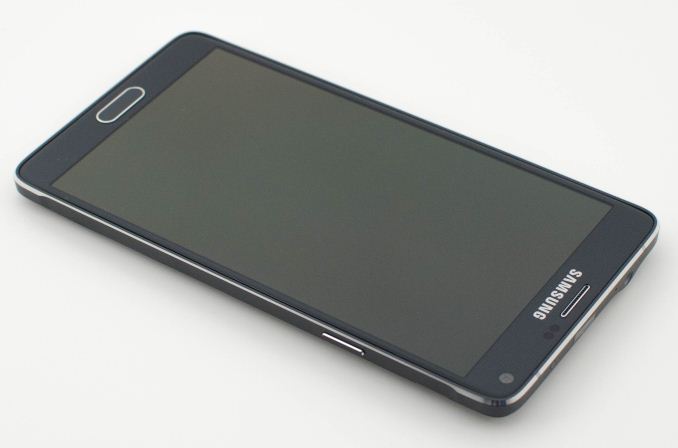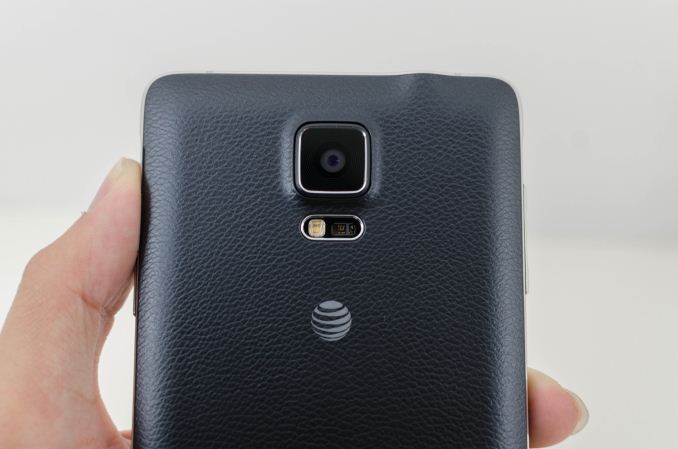The Samsung Galaxy Note 4 Review
by Joshua Ho on October 15, 2014 9:00 AM EST- Posted in
- Smartphones
- Samsung
- Android
- Mobile
- Galaxy Note 4
Final Words
The Galaxy Note 4 builds on the Galaxy S5 and Galaxy S5 LTE-A, but there’s still a lot to go over. We’ll break this down by section before coming to any real conclusions about this device. Based upon my time with the Galaxy Note 4, it’s clear to me that the most critical point of differentiation in the Galaxy Note 4 is the software experience. While other phones with TouchWiz can have similar features, it’s really a function of the hardware and additional feature support that comes with the Note 4 that makes the Galaxy Note more than just a big phone. The good news here is that Samsung continues to have a lot of great ideas in software, and many of the features tend to be quite helpful in nature. However, there’s a need to polish these features as the implementation tends to be rough around the edges. Overall, one shouldn’t have any significant issues with the software but Apple definitely has an edge in the polish department, even if the functionality isn’t as extensive.
The next key distinction is the display. The Galaxy Note is differentiated by its software, but defined by its display. It’s definitely big, and should be great for media consumption with its high contrast. More importantly, Samsung has continued to push better display calibration, brightness, and other areas where AMOLED was previously deficient. While there are still some issues with purple smearing and green tints to some level of grayscale, the AMOLED display is an equal to the 1080p display in the iPhone 6 Plus.
While the display defines the Galaxy Note 4 as a phablet, the design of the device itself is also important. To this end, Samsung has finally delivered a phone that feels as premium as its competition. While I do have some minor nitpicks regarding the design, on the whole it really is good enough that I don't have any real complaints. There are definitely phones and phablets out there that look and feel better, but the gap isn't large enough that it would count against the Note 4. The move to a unibody design would also mean that there wouldn't be a removable battery or microSD slot, which likely isn't worth the cost to Samsung in key markets like Korea that have a great need for both of those features.
While not quite as defining as the display, battery life is often one of the main draws of a larger phone. In this department, the Galaxy Note 4 does provide a level of improvement when compared to the Galaxy S5, but the higher resolution of the display means that battery life will slightly trail behind the iPhone 6 Plus. Despite this, no one should really have any issues getting a full day of use out of the Note 4. The adaptive fast charger also means that the Note 4 should be able to have better real-world battery life in scenarios where charge time is critical.
Finally, while unrelated to the formfactor itself, the Galaxy Note 4’s OIS has significant implications for low light performance and video quality. In practice Samsung’s OIS solution has a large accommodation angle and works well, although the use of OIS is closer to continuous rather in limited situations like on the iPhone 6 Plus. The use of OIS also makes it possible to go from the rather poor low light experience that we saw with the Galaxy S5 to a competitive one in the Note 4. While it isn't quite as good as the iPhone 6 Plus in low light, it makes up for it with higher resolution for daytime photography and similar situations where the 1.1 micron pixels aren't really a limitation.
We can talk more about the SoC performance, but at this point Snapdragon 805 is a known quantity. Instead, it's more important to talk about the Galaxy Note 4 as a whole, and on the whole Samsung continues to define the phablet segment with their features. For that alone, Samsung deserves praise as they continue to innovate in this space. If this innovation was also implemented with high levels of polish, I would have little issue calling the Galaxy Note 4 the best phablet on the market. As-is, the Galaxy Note 4 remains one of the best phablets on the market, but whether it's the best for a given user is a matter of priorities and personal preference rather than any absolutes.














195 Comments
View All Comments
akdj - Thursday, October 30, 2014 - link
Sorry. Something was lost in translation there;)I'm not going to go tbrough the dozen+ grammatical and punctuation errors, but my point was to compare iOS to Android with their siblings ...the Chromebook and OS X. Windows has the same if they're able to finally figure phones out! The SPIII is a HELLUVA design and enough difference between itself and the iPad (including the price, you're looking more like comparing a nice 13" rMBP w/Haswell ans Iris Pro graphics;))
Vertical and horizontal support. iOS and OS X with continuity and handoff being another extension of Airdrop is absolutely incredible!
The new near 15million pixel 5K iMac is a Grand Slam
iPad Air 2, it's A8X, a 2 and a ½ gen old 64 bit design---2GB of RAM, & a buck 28 built in with a half million 'optomized' tablet apps for everything from photo and video manipulation with Adobe, MS, & OS X integrated and aggregated alls to music creation, mixing and mastering ...magazines that are mind blowing, killer browser choices and unbelievably powerful video editing suites, drawing and sketching programs...old 'Chilton' fix 'em up guides or ForeFlight to file your F/P n tell ya how much gas you should pump in, while it considers diversions and real time weather and traffic. TCAS ans ADSB ...Jep charts, plates and updates in 'now' time, THAT'S a 'Tool!'
Farting around with ROMS is like rewiring your microwave. Why? It's to cook, melt, boil, or pop your F'ung popcorn!
tipoo - Wednesday, October 15, 2014 - link
Indeed. I'm excited for Nvidias Denver CPU cores, finally someone else going with two big cores rather than four small.mpokwsths - Wednesday, October 15, 2014 - link
Something is not right here..."Around 450 nits" with auto brightness on???
Displaymate strongly disagrees with Anandtech. They measured "478 - 750 cd/m2" with auto brightness (1 nit = 1 cd/m2)
http://www.displaymate.com/Galaxy_Note4_ShootOut_1...
melgross - Wednesday, October 15, 2014 - link
There is variability in production. The differences you are seeing are well within that variability.mpokwsths - Wednesday, October 15, 2014 - link
Don't be ridiculous, please...Displaymate: "When Automatic Brightness is turned On, the Galaxy Note 4 reaches an impressive 750 cd/m2 in High Ambient Light, where high Brightness is really needed – it is the brightest mobile display that we have ever tested"
It is an out-of-space claim that there can be a variability in production of a 70% level...
tralalalalalala40 - Saturday, October 18, 2014 - link
hopefully the display doesn't keep that brightness very long. those pentile pixels will burn out. you'll have to use a screen saver.theduckofdeath - Thursday, October 16, 2014 - link
Sounds like a poor excuse for inaccurate testing to me. If the error margin was that huge, the display would be horrible to look at.JoshHo - Wednesday, October 15, 2014 - link
In practice I find that the 100% APL value is more representative of the perceived brightness, this is due to a difference in testing methodology.Pissedoffyouth - Wednesday, October 15, 2014 - link
I just bought a note 3, and I'm more than happy with it with a zerolemon 10000mah battery. This doesn't really offer much more really, more of an slight upgrade.I'd be interested to see why they didn't up the battery a little more considering they made the chassis bigger...
darkich - Wednesday, October 15, 2014 - link
I find it impossible not to notice the Apple reality distortion effect in this article.But nice try hiding it, AT.
I'll just state a fact proven by pretty much every other review - battery endurance on this device is clearly better than that on the iPhone 6+.